
An obelisk is a tall, four-sided, narrow tapering monument which ends in a pyramid-like shape or pyramidion at the top. Originally constructed by Ancient Egyptians and called tekhenu, the Greeks used the Greek term obeliskos to describe them, and this word passed into Latin and ultimately English. Though William Thomas used the term correctly in his Historie of Italie of 1549, by the late sixteenth century, Shakespeare failed to distinguish between pyramids and obelisks in his plays and sonnets. Ancient obelisks are monolithic and consist of a single stone; most modern obelisks are made of several stones.

Nelson's Column is a monument in Trafalgar Square in the City of Westminster, Central London, built to commemorate Vice-Admiral Horatio Nelson's decisive victory at the Battle of Trafalgar over the combined French and Spanish navies, during which he lost his life, killed by a French sniper. The monument was constructed between 1840 and 1843 to a design by William Railton at a cost of £47,000. It is a column of the Corinthian order built from Dartmoor granite. The statue of Nelson was carved from Craigleith sandstone by sculptor Edward Hodges Baily. The four bronze lions around its base, designed by Sir Edwin Landseer, were added in 1867.
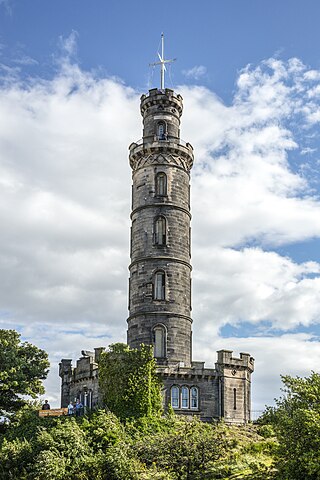
The Nelson Monument is a commemorative tower in honour of Vice Admiral Horatio Nelson, located in Edinburgh, Scotland. It is situated on top of Calton Hill, and provides a dramatic termination to the vista along Princes Street from the west. The monument was built between 1807 and 1816 to commemorate Nelson's victory over the French and Spanish fleets at the Battle of Trafalgar in 1805, and his own death at the same battle. In 1852 a mechanized time ball was added, as a time signal to shipping in Leith harbour. The time ball is synchronized with the One O'Clock Gun firing from Edinburgh Castle. The monument was restored in 2009.

Alexander Davison (1750–1829) was an English businessman and government contractor. He was a contemporary and close friend of Admiral Lord Nelson.
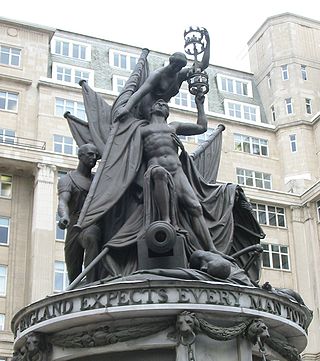
The Nelson Monument is a monument to Admiral Horatio Nelson, in Exchange Flags, Liverpool, England. It was designed by Matthew Cotes Wyatt and sculpted by Richard Westmacott. It stands to the north of the Town Hall and was unveiled in 1813.

The Nile Clumps are a series of tree clumps just west of Amesbury on Salisbury Plain in Wiltshire, England, planted in the early 19th century purportedly to commemorate the Battle of the Nile.
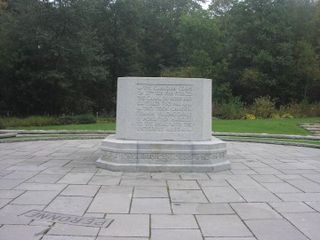
The Bourlon Wood Memorial, near Bourlon, France, is a Canadian war memorial that commemorates the actions of the Canadian Corps during the final months of the First World War; a period also known as Canada's Hundred Days, part of the Hundred Days Offensive.
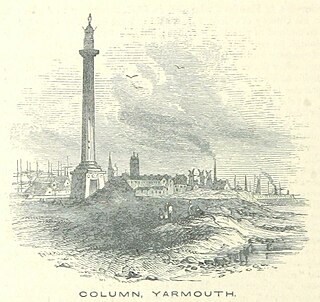
The Nelson's Monument is a commemorative column or tower built in memorial to Admiral Horatio Nelson, situated on the Denes, Great Yarmouth in the county of Norfolk, England. It was designated as a Grade I listed structure in 1953.
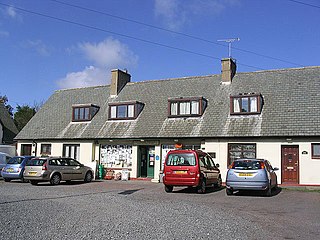
Swarland is a small modern village and former civil parish, now in the parish of Newton-on-the-Moor and Swarland, in the county of Northumberland, England, situated about 7 miles (11 km) south of the market town of Alnwick and 25 miles (40 km) north of the city of Newcastle upon Tyne. In 1951 the parish had a population of 368.

The Statue of Horatio Nelson by Richard Westmacott, RA (1775–1856) stands in the Bull Ring, Birmingham, England.

The Trafalgar Cemetery is a cemetery in the British Overseas Territory of Gibraltar. Formerly known as the Southport Ditch Cemetery, it occupies a small area of land just to the south of the city walls, in what had been a defensive ditch during the period of Spanish rule of Gibraltar. Although it is named for the Battle of Trafalgar of 21 October 1805, only two victims of the battle are buried there. The remainder of the interments are mostly of those killed in other sea battles or casualties of the yellow fever epidemics that swept Gibraltar between 1804 and 1814. In addition, tombstones were transferred to the Trafalgar Cemetery from St. Jago's Cemetery and Alameda Gardens.

Horatio Nelson, 1st Viscount Nelson (1758–1805) was a British flag officer in the Royal Navy famous for his participation in the Napoleonic Wars, most notably in the Battle of Trafalgar, during which he was killed. He was responsible for several famous victories that helped to secure British control of the seas, both securing Britain from French invasion and frustrating Napoleon's imperial ambitions. After his death during his defeat of the combined French and Spanish fleets at Trafalgar, there was a public outpouring of grief. Nelson was accorded a state funeral and was buried in St Paul's Cathedral.

Nelson's Column is a monument, designed by Scottish architect Robert Mitchell and erected in 1809 in Place Jacques-Cartier, Montreal, Quebec, Canada, which is dedicated to the memory of Admiral Horatio Nelson, following his death at the Battle of Trafalgar. Subsequent to the destruction of Nelson's Pillar in Dublin (1808–1966), Montreal's pillar now stands as the second-oldest "Nelson's Column" in the world, after the Nelson Monument in Glasgow. It is also the city's oldest monument and is the oldest war monument in Canada.

Nelson's Pillar was a large granite column capped by a statue of Horatio Nelson, built in the centre of what was then Sackville Street in Dublin, Ireland. Completed in 1809 when Ireland was part of the United Kingdom, it survived until March 1966, when it was severely damaged by explosives planted by Irish republicans. Its remnants were later destroyed by the Irish Army.
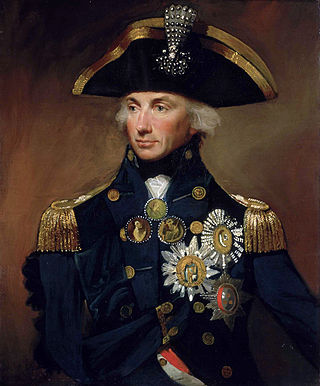
Vice-Admiral Horatio Nelson, 1st Viscount Nelson, 1st Duke of Bronte was a British flag officer in the Royal Navy. His inspirational leadership, grasp of strategy and unconventional tactics brought about a number of decisive British naval victories during the French Revolutionary and Napoleonic Wars. He is widely regarded as one of the greatest naval commanders in history. His victory on 21 October 1805 at the Battle of Trafalgar led to British naval supremacy for over another century and beyond.

The Old Steine Gardens in Brighton, Brighton and Hove, East Sussex, England, adjacent to the Old Steine thoroughfare, are the site of several monuments of national historic significance.

Southport War Memorial is in London Square, Lord Street, Southport, Merseyside, England. It consists of an obelisk flanked by two colonnades in the form of Greek temples. Outside the colonnades are memorial gardens, each containing a Pool of Remembrance and fountains. The memorial was designed by the local architects Grayson and Barnish, and the carving was executed by Herbert Tyson Smith. It was unveiled in 1923 by the Earl of Derby. Following the Second World War and subsequent conflicts further inscriptions and names have been added. The memorial is recorded in the National Heritage List for England as a designated Grade II* listed building.

The Royal Naval Division Memorial is a First World War memorial located on Horse Guards Parade in central London, and dedicated to members of the 63rd Division (RND) killed in that conflict. Sir Edwin Lutyens designed the memorial, which was unveiled on 25 April 1925—ten years to the day after the Gallipoli landings, in which the division suffered heavy casualties. Shortly after the war, former members of the division established a committee, chaired by one of their leading officers, Brigadier-General Arthur Asquith, to raise funds for a memorial. Progress was initially slow. The committee planned to incorporate its memorial into a larger monument proposed by the Royal Navy for Trafalgar Square. When the navy abandoned that project, the RND's committee decided to proceed independently. They engaged Lutyens, who, after negotiation with the Office of Works, produced a design for a fountain connected to the balustrade of the Admiralty Extension building.

The Simeon Monument, also known as the Soane Obelisk, the Soane Monument and the Simeon Obelisk, is a stone structure in Market Place, the former site of the market in Reading, Berkshire. It was commissioned by Edward Simeon, a Reading-born merchant who became extremely wealthy as a City of London trader. Edward Simeon's brother, John, was a former Member of Parliament for Reading who had lost his seat in the 1802 elections to the parliament of the newly created United Kingdom of Great Britain and Ireland, since which time the family had been engaged in ostentatious spending locally in an effort to gain support among the town's voters.

Cleopatra's Needle in London is one of a pair of obelisks, together named Cleopatra's Needles, that were moved from the ruins of the Caesareum of Alexandria, in Egypt, in the 19th century. Inscribed by Thutmose III and later Ramesses II of the Egyptian New Kingdom, the obelisk was moved in 12 BC to Alexandria, where it remained for over 1,800 years.





















